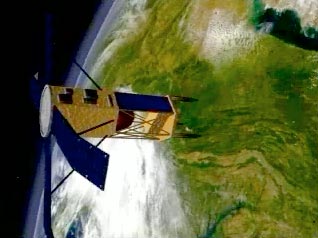


Ever since SeaWiFS was launched back in August of 1997, I had hoped to figure out some way of getting a high resolution satellite receiving station installed on the islands to collect a time series that would once and for all provide a data set for generations to come that would help characterize the ocean’s biological response to a changing environment in this most unique part of the world. Unfortunately, things never seemed to work out quite right until a cold November day in 2000 when I first met Stuart Banks. After a number of e-mail exchanges with some folks in Galapagos and Stuart, his travel plans were changed at the last minute so that he stopped off at Goddard on his way down to the Galapagos for the second time and spent the evening at my home and the next day at Goddard where together with John Morrison (see his journal for the details), we hatched a plan that was to profoundly influence the course of both of our lives. To this day, both my daughters who were 17 and 12 at the time remember the night they had dinner with this very charming young man from Great Britain with the terrific accent. For me, it was realization of a dream that started back in 1982 when I first started observing these marvelous islands from space with data from the Coastal Zone Color Scanner. For Stuart, it was the start of what was to become an incredible scientific and personal adventure that continues to this day.
I asked Stuart to try and find some time in between the continuous diving and data logging that has filled his team’s days onboard the M/V Queen Mabel to provide a more personal perspective on his work here in Galapagos. True to form, Stuart went way beyond what I could have ever hoped for and here is what he wrote.
Sending my best regards while at anchor off the northeast tip of Fernandina.
gene
Editor’s note: A second Spanish-only guest blog, from Gene’s shipmate Nathalia Tirado Sánchez, describes how a family vacation to the tropics when she was five ended up with them staying to live on the Galapagos. At that age, she remembers feeling like she had gone back in time, to a place where dinosaurs (marine iguanas) still lived. Volunteer work with the Charles Darwin Foundation fostered a strong desire to do work that was connected to the ocean life of the islands. Today, she is studying the relationship between ocean conditions and the zooplankton of the Galapagos. At the end of her post, she talks about how important it is to her to teach her children and the rest of their generation about the unique ecology of the Galapagos so that those who love the islands and want to live there have the information they need to preserve the place they love for future generations.

Editor’s Note. Two of Gene’s shipmates on the Mabel, whom he invited to guest blog, submitted their posts in Spanish, with no translation. Biologist Jerson Moreno is describing the activities he has been involved in since he started working the Galapagos in 1998, most of them involving monitoring small marine animals such as fish and lobster. For those who don’t speak Spanish, any web-based translation program can give you a rough idea of what he has been up to.


My main role within the Charles Darwin Foundation is to be aware of the safety during the field activities in the marine and terrestrial areas. I also participate in the different marine research projects that are going on. In the ecological Monitoring after seven years of participation; I identify and take notes of the number and size of the fishes inside the transects we run across the entire Marine Reserve of this wonderful and unique paradise.

Since 2006, I’ve been an Associate Researcher at Marine Ecosystem Monitoring Program of the Charles Darwin Foundation, and also an Associate Researcher at Nazca Institute of Marine Research since 2003.